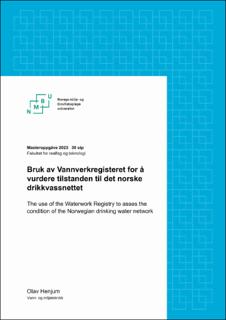| dc.contributor.advisor | Vegard Nilsen | |
| dc.contributor.author | Henjum, Olav | |
| dc.date.accessioned | 2023-07-15T16:27:23Z | |
| dc.date.available | 2023-07-15T16:27:23Z | |
| dc.date.issued | 2023 | |
| dc.identifier | no.nmbu:wiseflow:6839593:54592440 | |
| dc.identifier.uri | https://hdl.handle.net/11250/3079278 | |
| dc.description.abstract | I dag har Noreg ei høg mengd lekkasjar på dei kommunale vassleidningane samanlikna med
nabolanda. Dette har store konsekvensar for kvaliteten på drikkevatnet, økonomien, og miljøet.
Årsaka er at fornyingstakten på vassleidningar er får låg i forhold til behovet for utskifting samt eit
stort etterslep på vedlikehald av vassleidningar. For å redusere lekkasjedelen, krevst det derfor tiltak.
Kvart år sender kommunane regelmessig inn data som omhandlar vasskvaliteten og tilstanden på
leidningsnettet til Mattilsynet. Mykje av informasjonen frå rapporteringane blir samansett og
presentert årleg i ein rapport skrevet av Folkehelseinstituttet. Dei har som formål å illustrera
statusen på leidningsnettet og drikkevasskvaliteten til befolkninga. Det er likevel mykje av
informasjonen som er utforande å analysera på grunn av usikkerheitene i dei innrapporterte dataa.
I denne studien blei det gjort analysar av dei innrapportere dataa som organisera informasjonen med
hensikt for å gi betre oversikt over leidningsnettet. Det blei framstilt trendar og endringar for ulike
leggjeperiodar, material og lekkasjereperasjonar for å gi ein vurdering på kvaliteten til dataa som blir
rapportert inn frå kommunane. Det blei også utført ei regresjonsanalyse som kan estimere korleis
leidningsnettet kan sjå ut i 2040.
Frå analysearbeidet var det mogleg å trekka samanhengar mellom trendane ein såg og den historiske
bakgrunnen om leidningsnettet til Noreg, samt estimere korleis leidningsnettet vil sjå ut i framtida.
Det er derimot ein del unormale trendar som auking av leidningslengde i utgåtte periodar og
unaturlege observasjonar. Årsaka til dette var det utdaterte rapporteringssystemet, som resulterer i
at dataa som rapporterast inn er svært generelle og at det må gjerast manuelt. Dette fører til at
kvaliteten på rapporteringa blir personavhengig og manglar detaljar som er nødvendige for en
grundig analyse.
Oppgåva konkludera med at den innrapporterte dataa kan illustrere estimat over korleis
leidningsnettet i Norge ser ut i dag og utvikla fram mot 2040 , men at det vil likevel ikkje bidra til å
forbetre strategien for leidningsfornying på grunn av den betydeleg usikkerheita. Oppgåva anbefaler
at ein samanfattar større mengde med historiske data som kan tydeleggjere trendane og redusere
usikkerheita. | |
| dc.description.abstract | Today, Norway has a high number of leaks in its municipal water pipelines compared to neighboring
countries. This has significant consequences for the quality of drinking water, the economy, and the
environment. The reason is that the rate of pipeline renewal is too low in relation to the replacement
needs, as well as a large backlog in pipeline maintenance. Measures are therefore required to reduce
the proportion of leaks.
Each year, municipalities regularly submit data concerning water quality and the condition of the
pipeline network to the Norwegian Food Safety Authority. Much of the information from these
reports is compiled and presented annually in a report written by the Norwegian Institute of Public
Health. Its purpose is to illustrate the status of the pipeline network and the drinking water quality
for the population. However, much of the information is challenging to analyze due to uncertainties
in the reported data.
This study conducted analyses of the reported data to organize the information with the aim of
providing a better overview of the pipeline network. Trends and changes were presented for
different time periods, materials, and leak repairs to assess the quality of the data reported by the
municipalities. A regression analysis was also performed to estimate how the pipeline network might
look in 2040.
From the analysis work, it was possible to identify correlations between the observed trends and the
historical background of Norway's pipeline network, as well as estimate how the network will appear
in the future. However, there are some abnormal trends, such as an increase in pipeline length in
outdated periods and unnatural observations. The cause of this was the outdated reporting system,
resulting in the reported data being very generalized and requiring manual input. This leads to the
reporting quality being person-dependent and lacking the necessary details for a thorough analysis.
The thesis concludes that the reported data can illustrate estimates of the current state of Norway's
pipeline network and its development towards 2040. However, it will not contribute to improving the
strategy for pipeline renewal due to the significant uncertainty. The thesis recommends summarizing
larger amounts of historical data to clarify the trends and reduce the uncertainty. | |
| dc.language | nno | |
| dc.publisher | Norwegian University of Life Sciences | |
| dc.title | Bruk av Vannverkregisteret for å vurdere tilstanden til det norske drikkvassnettet | |
| dc.type | Master thesis | |
